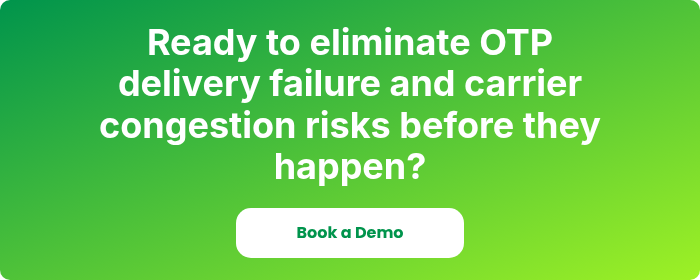 Klearcom
Klearcom
Black Friday is a stress test not just for retailers, but for the digital infrastructure that powers real-time communication. It’s not just websites and apps that feel the pressure. Behind every login, transaction, delivery alert, and two-factor authentication lies a complex network of text messaging routes and telecom providers. And when demand spikes, that infrastructure can break.
During peak shopping hours on Black Friday, text messaging volume explodes. Brands launch flash sales. Customers flood e-commerce apps.
OTPs, or one-time passwords, are sent by the millions for account access and payment verification. Promotional texts, shipping updates, and fraud alerts also crowd the pipelines. It all happens at once and it overwhelms the system.
This results in a massive surge of SMS messages hitting mobile networks, often leading to black friday sms delays. The culprit is often carrier congestion.
As networks reach capacity, messages start to queue. Some are delayed. Some are never delivered.
For transactional texts like SMS OTP codes or fraud alerts, those delays become business-critical. When messages are late, customers can’t log in, complete purchases, or trust the experience. The result is an otp delivery failure that directly affects your revenue, your reputation, and your conversion rates.
In this article, we’ll explore why Black Friday SMS issues occur, the hidden costs of OTP failures, and how to prevent delivery issues before they disrupt your operations. You’ll also learn how proactive testing and carrier diversity can protect your communications, and why SMS performance must be part of your holiday marketing strategy.
Why SMS Delivery Fails During Black Friday
To understand the failure, you have to understand the traffic. Black Friday brings the biggest surge in consumer messaging all year.
Businesses send everything from time-sensitive discount alerts to critical transactional messages, all expecting instant delivery. But mobile carriers operate within finite bandwidth. Once their SMS delivery pipelines fill up, new messages must wait in line - or worse, they vanish into the void.
This is carrier congestion in action, and it often starts earlier than you think. During pre-sale marketing pushes, promotional SMS messages flood networks. Many of these are scheduled during peak business hours or based on outdated send time estimates, further amplifying bottlenecks.
Compounding the problem is port congestion in telecom infrastructure. Just like in global supply chain logistics, telecom networks suffer when capacity planning falls short. If a regional carrier experiences a port delay, thousands of messages may be held up. Add in labor shortages or system misconfigurations at the carrier level, and you have the perfect storm.
Retailers may see delivery failures without realizing it until customers complain. And by then, it’s too late. OTPs have expired. Support queues are backed up. Revenue has already slipped away.
The Real Business Impact of OTP Delays
A one-time password (OTP) is a single-use code sent to customers to verify identity during login, transactions, or sensitive account changes. During Black Friday, they play a central role in customer engagement and fraud prevention.
But these codes are time sensitive. Most expire within 30 to 60 seconds. If they’re delayed due to SMS congestion, the experience breaks.
Customers get stuck at checkout. They can’t log in. They abandon carts or switch to competitors.
Some may reach out to support, increasing cost-to-serve. But many will simply walk away and their trust may not return.
Otp delivery failure also affects customer support and fraud prevention. If authentication codes are delayed or dropped, legitimate transactions may be blocked or delayed. That increases false positives and erodes trust.
Consider the ripple effects: customers who fail to receive their SMS OTPs may retry multiple times, overloading your system. Others may move to messaging apps or email for assistance. Either way, your planned user flow is broken, and your conversion rates drop.
Now multiply that by tens of thousands of interactions during Black Friday. The losses add up quickly.
Why Carrier Diversity and Testing Matter
Many companies use a single telecom provider or route for their SMS traffic. It’s simple, until it isn’t. If that route becomes saturated or if a single point in the chain fails, all messages queued there are impacted.
That’s why redundancy and carrier diversity are critical. By testing across multiple carriers in each market, you gain visibility into where failures may occur. For example, one carrier might route SMS OTP messages quickly in France but delay them in Germany. A proactive testing strategy identifies this ahead of time.
SMS delivery isn’t just about having a sender ID or a valid number. It’s about making sure the message travels from your platform to the customer’s phone reliably. That path includes carrier handoffs, formatting requirements, route prioritization, and even local regulations.
Most businesses discover issues too late. With real-time monitoring, you can detect them early.
How Klearcom Helps You Detect Failures in Real Time
Klearcom offers a proactive SMS testing solution designed to simulate real customer interactions across global networks. Before Black Friday, and throughout the holiday season, Klearcom tests your SMS infrastructure continuously.
That means you’ll see exactly how long it takes for a message to reach a recipient’s phone in-country. If there’s a delay, you’ll know. If a carrier fails to deliver, you’ll see it and get an alert. Every test is logged. Every route is verified.
Klearcom’s platform provides deep insight into SMS message paths, send time latency, sender/receiver integrity, and content accuracy. You can test from any region, validate across multiple carriers, and simulate both transactional and promotional flows.
This allows you to uncover and fix failures long before your customers feel them. It also empowers you to hold telecom vendors accountable, improve message routing, and support your compliance needs.
Steps to Prepare Your Messaging for Peak Traffic
Start with a baseline. Know your current message delivery times across key markets. Run tests using different carriers and from multiple geographies. Identify weak points.
Then, layer in redundancy. Work with vendors who support multi-carrier testing and failover. Ensure your SMS platform can reroute based on performance.
Align your marketing strategy with telecom realities. Don’t schedule high-volume campaigns during known peak windows without testing capacity. Adjust your send time based on real-world data, not assumptions.
Create a fallback plan for critical flows. For example, if an OTP fails to deliver via SMS, can you send a backup code through a messaging app or email? If not, customers may hit a dead end.
Monitor performance during the event. Don’t wait for customer complaints. Use live dashboards to track latency, delivery success, and message health.
And finally, communicate internally. Let your IT, CX, and marketing teams know that SMS infrastructure is part of the customer experience. It’s not just a telecom issue, it’s a business-critical asset.
Long-Term Benefits of SMS Visibility and Control
Black Friday might be the catalyst, but the need for SMS testing extends far beyond a single weekend. Businesses now depend on text messaging year-round for authentication, support, and updates.
Customer expectations are evolving. They expect instant, reliable communication across all channels. When your phone numbers or routing tables break, their experience breaks too.
With continuous SMS monitoring, you can improve delivery rates, reduce friction, and enhance trust. Over time, this supports higher engagement, better security, and more efficient operations.
It also informs your long term vendor strategy. If certain carriers or routes consistently underperform, you can make data-backed decisions to switch or renegotiate. You can also document compliance for regulated industries where message retention and audit trails matter.
SMS visibility isn’t just about avoiding downtime. It’s about building a resilient, high-performing communications stack.
Don’t Let Messaging Failures Cost You Customers
Black Friday creates immense opportunity. But it also exposes any weak link in your communications. OTP failures, delayed SMS messages, and routing issues are all preventable if you can see them coming.
With Klearcom, you can gain that visibility. You can validate your infrastructure, detect issues in real time, and ensure your SMS OTP codes arrive on time. So when demand surges, your customer experience remains seamless.


